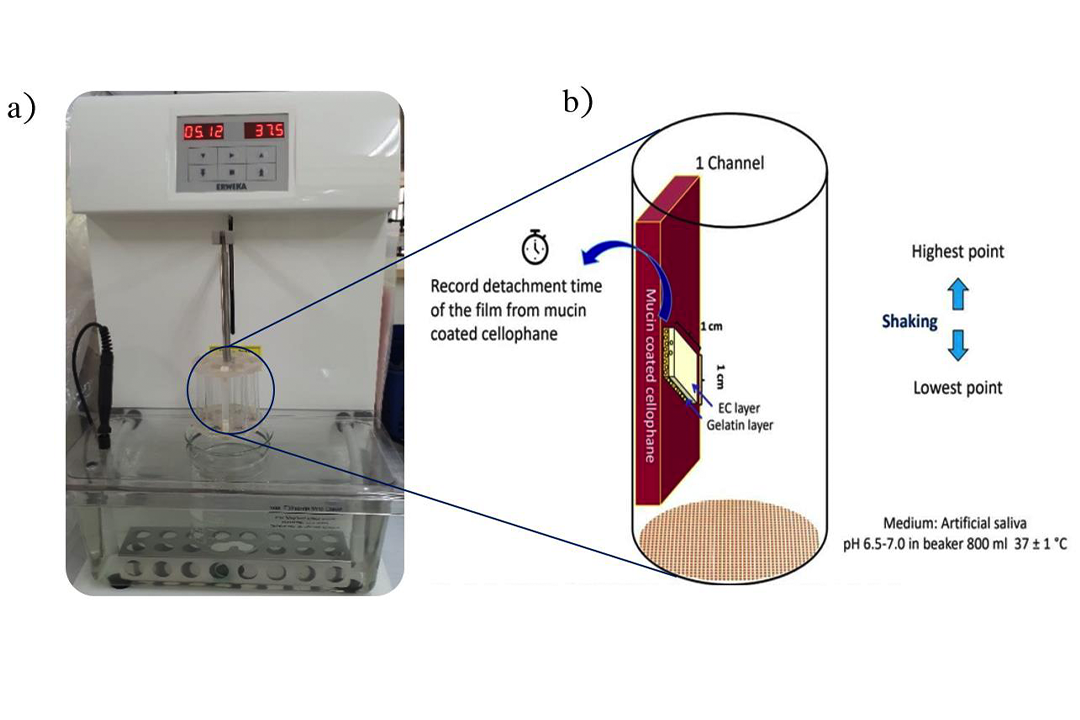Development of mucoadhesive gelatin-based patches for aphthous ulcers
DOI:
https://doi.org/10.14456/nujst.2023.24Keywords:
mucoadhesive patches, gelatin, α-mangostin, plasticizer, in vitro residence timeAbstract
Mucoadhesive patches demonstrate considerable promise for the administration of therapeutics targeting oral mucosal diseases. This study employed the solvent casting technique to fabricate mucoadhesive patches and examine the influence of bloom strength variation, plasticizer concentration, gelatin concentration, and alpha-mangostin (α-MN) loading on patch properties. The mucoadhesive patches consisted of a 5% ethylcellulose backing layer, a mucoadhesive layer combining ethylcellulose and gelatin, and a gelatin layer loaded with α-MN. The investigation revealed that augmented gelatin bloom strength correlated with increased puncture strength and elongation at break, but diminished thickness. Owing to its superior characteristics, 300-bloom gelatin was chosen for further examination. The incorporation of glycerin as a plasticizer decreased puncture strength but enhanced elongation at break. An escalation in gelatin concentration from 1% to 7% resulted in amplified patch thickness and puncture strength, with 7% gelatin yielding the most pliable patches. Additionally, the in vitro residence time of the patches rose concomitantly with increasing gelatin concentrations, attributable to heightened interpenetration with mucin chains and the formation of mucoadhesive bonds. Successful α-MN loading into the patches was achieved, exhibiting an actual concentration range of 144.12 ± 27.10 µg to 441.05 ± 94.79 µg. In summary, this study successfully generated mucoadhesive patches exhibiting desirable properties for potential oral mucosal drug delivery applications. These findings serve as a foundation for subsequent optimization and development of mucoadhesive patches to address various oral mucosal diseases.
References
Ahmady, A., & Abu Samah, N. H. (2021). A review: Gelatine as a bioadhesive material for medical and pharmaceutical applications. International Journal of Pharmaceutics, 608, 121037. https://doi.org/10.1016/j.ijpharm.2021.121037
Bafi-Yeboa, N. F. A., Arnason, J. T., Baker, J., & Smith, M. L. (2005). Antifungal constituents of Northern prickly ash, Zanthoxylum americanum Mill. Phytomedicine, 12(5), 370-377. https://doi.org/10.1016/j.phymed.2003.12.005
Ballesteros-Mártinez, L., Pérez-Cervera, C., & Andrade-Pizarro, R. (2020). Effect of glycerol and sorbitol concentrations on mechanical, optical, and barrier properties of sweet potato starch film. NFS Journal, 20, 1-9. https://doi.org/10.1016/j.nfs.2020.06.002
Belenguer-Guallar, I., Jiménez-Soriano, Y., & Claramunt-Lozano, A. (2014). Treatment of recurrent aphthous stomatitis. A literature review. Journal of Clinical and Experimental Dentistry, 6(2), e168-174. https://doi.org/10.4317/jced.51401
Chen, L.-G., Yang, L.-L., & Wang, C.-C. (2008). Anti-inflammatory activity of mangostins from Garcinia mangostana. Food and Chemical Toxicology, 46(2), 688-693. https://doi.org/10.1016/j.fct.2007.09.096
Chiang, C.-P., Yu-Fong Chang, J., Wang, Y.-P., Wu, Y.-H., Wu, Y.-C., & Sun, A. (2019). Recurrent aphthous stomatitis – Etiology, serum autoantibodies, anemia, hematinic deficiencies, and management. Journal of the Formosan Medical Association, 118(9), 1279-1289. https://doi.org/10.1016/j.jfma.2018.10.023
Hägerström, H., Paulsson, M., & Edsman, K. (2000). Evaluation of mucoadhesion for two polyelectrolyte gels in simulated physiological conditions using a rheological method.European Journal of Pharmaceutical Sciences, 9(3), 301-309. https://doi.org/10.1016/S0928-0987(99)00070-6
Kadam, Y., Pochat-Bohatier, C., Sanchez, J., & El Ghzaoui, A. (2015). Modulating Viscoelastic Properties of Physically Crosslinked Self-Assembled Gelatin Hydrogels through Optimized Solvent Conditions. Journal of Dispersion Science and Technology, 36(9), 1349-1356. https://doi.org/10.1080/01932691.2014.984721
Kriangkrai, W., Puttipipatkhachorn, S., Sriamornsak, P., Pongjanyakul, T., & Sungthongjeen, S. (2012). Magnesium stearate as anti-tacking agent in acrylic polymer films intended for gas-entrapped floating delivery system. Advanced Materials Research, 506, 497-500. https://doi.org/10.4028/www.scientific.net/AMR.506.497
Leuenberger, B. H. (1991). Investigation of viscosity and gelation properties of different mammalian and fish gelatins. Food Hydrocoll, 5(4), 353-361. https://doi.org/10.1016/S0268-005X(09)80047-7
Mali, S., Grossmann, M. V. E., Garcı´a, M. A., Martino, M. N., & Zaritzky, N. E. (2005). Mechanical and thermal properties of yam starch films. Food Hydrocoll, 19(1), 157-164. https://doi.org/10.1016/j.foodhyd.2004.05.002
Mohan, S., Syam, S., Abdelwahab, S. I., & Thangavel, N. (2018). An anti-inflammatory molecular mechanism of action of α-mangostin, the major xanthone from the pericarp of Garcinia mangostana: An in silico, in vitro and in vivo approach. Food Function, 9(7), 3860-3871.
Peppas, N. A., Hilt, J. Z., Khademhosseini, A., & Langer, R. (2006). Hydrogels in Biology and Medicine: From Molecular Principles to Bionanotechnology. Advanced Materials, 18(11), 1345-1360. https://doi.org/10.1002/adma.200501612
Pham, D. T., Saelim, N., & Tiyaboonchai, W. (2019). Alpha mangostin loaded crosslinked silk fibroin-based nanoparticles for cancer chemotherapy. Colloids and Surfaces B, 181, 705-713. https://doi.org/10.1016/j.colsurfb.2019.06.011
Taokaew, S., Phonsee, S., Woravut, N., Pitaksuteepong, T., & Kriangkrai, W. (2019). Characteristic assessment of the polymeric films used for hair gel products in thailand. Key Engineering, 819, 98-103. https://doi.org/10.4028/www.scientific.net/KEM.819.98
Taokaew, S., Wattanaphraya, N., & Kriangkrai, W. (2020). Characterization of rheological property of mucoadhesive polymeric sol-gel in the presence of black ginger kaempferia parviflora extract. Key Engineering, 859, 81-86. https://doi.org/10.4028/www.scientific.net/KEM.859.81
Tiwari, D., Sause, R., Madan, P. L., & Goldman, D. (1999). Evaluation of polyoxyethylene homopolymers for buccal bioadhesive drug delivery device formulations. AAPS PharmSciTech, 1, 50-57. https://doi.org/10.1208/ps010313
Tzanova, M. M., Hagesaether, E., & Tho, I. (2021). Solid lipid nanoparticle-loaded mucoadhesive buccal films – Critical quality attributes and in vitro safety & efficacy. International Journal of Pharmaceutics, 592, 120100. https://doi.org/10.1016/j.ijpharm.2020.120100
Wattanaphraya, N., Manchun, S., Taokaew, S., & Kriangkrai, W. (2021). Development of Mucoadhesive Film-Forming Systems Containing Black Ginger Extract for Aphthous Ulcers. Key Engineering, 901, 104-110. https://doi.org/10.4028/www.scientific.net/KEM.901.104

Downloads
Published
How to Cite
Issue
Section
License
Copyright (c) 2023 Naresuan University Journal: Science and Technology (NUJST)

This work is licensed under a Creative Commons Attribution-NonCommercial 4.0 International License.













